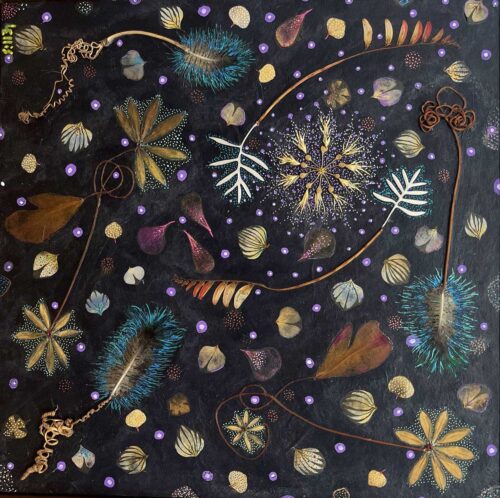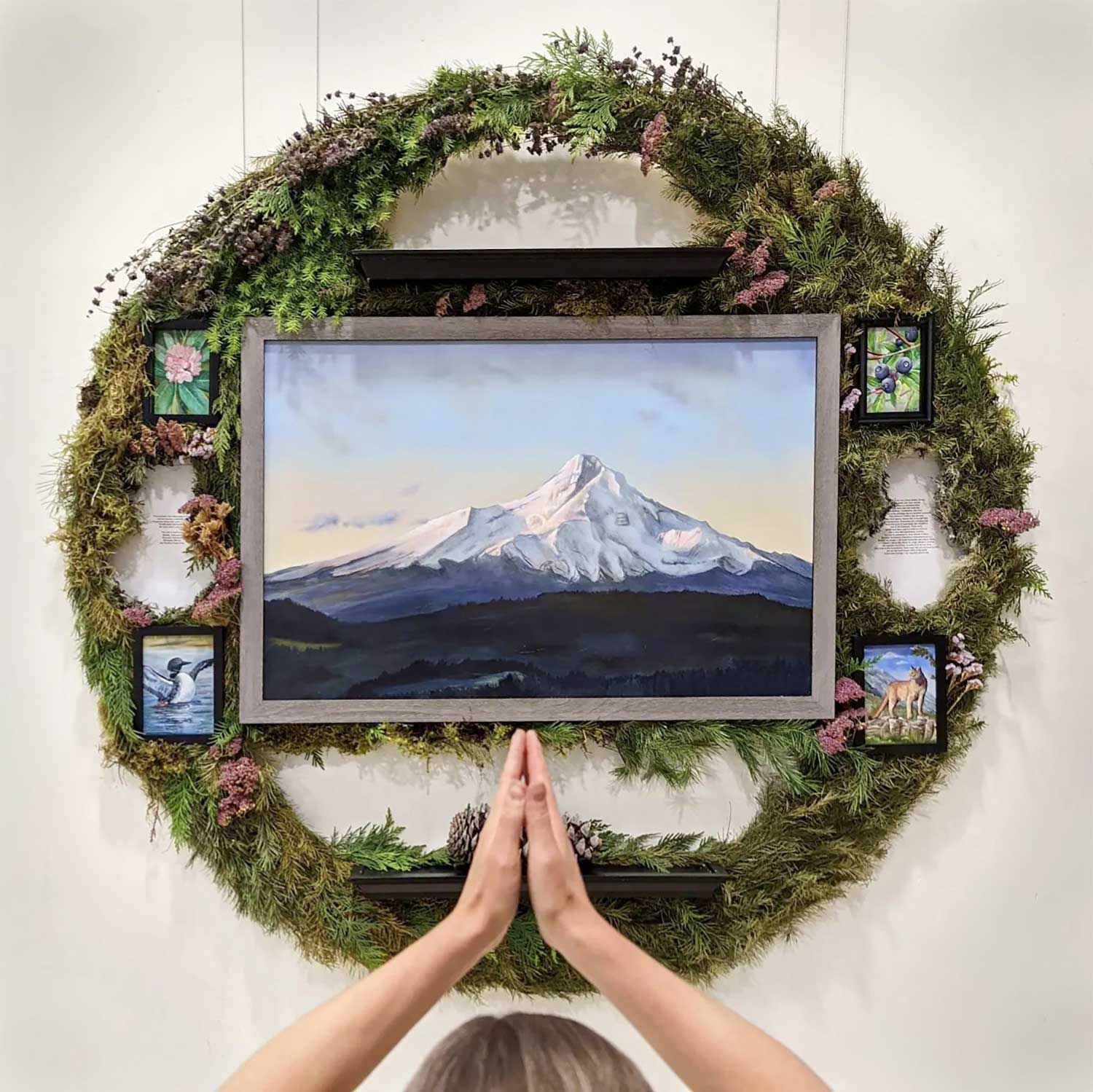
Maude Kerns Art Center is presenting the work of four artists who are immersed in the practice of representing and utilizing elements from the natural world. Land as Deity is Barbara Counsil Burney’s solo show in the Salon Gallery. Circling the Grove, in the center’s main room, is a group show that presents work by three artists: Lisa Brinkman, Carissa Burkett and Leanne Ellis. Both exhibits are on view until August 23.
Burney says her goal is to “inspire people to protect undeveloped wilderness areas,” and her artworks are designed as “altars.” With titles like “The Altar to Fort Rock,” and “The Altar to the Mount Hood National Forest,” they offer images of landscapes and of animals and plants that live on the land.
Framing art within the concept of an altar works so well, in part, because the idea that land is sacred is culturally universal. From Mount Sinai in Egypt, where the Ten Commandments are said to have been given to Moses, to Mount Hood in Oregon, which is a spiritual site to multiple Indigenous cultures, including the Clackamas and Cascade Chinook, the approach is instantly recognizable.
Each of Burney’s works are multimedia composites that include small oil paintings and a central larger one assembled into a circular-shaped altar along with other natural and human-made elements. The center painting is always a landscape picturing the title’s subject, and the smaller paintings depict animals and plants living in that particular environment.
It is a framework at once spiritual and commercial. Though her works suggest worship, they are also sold by their individual components. For example, “Altar to Lake Superior” features the central painting “Lake Superior” which is still available and priced at $1,500, but smaller paintings within the altar, like “Snapping Turtle” priced at $75, have already been sold.
You might think that dismantling the altars contradicts their integrity. But there are cultural examples that support the practice of breaking apart holy objects, such as traditional sandpaintings which are destroyed and scattered back to the earth after their use in religious ceremonies. Burney’s artworks are not scattered, they are sold. Still the idea is, the pieces are bought so that the land they represent is appreciated.
Tearing down an artwork into smaller components corresponds to the gift store approach to sales. If you can’t afford the large piece on view, then exit through the gift shop where you can buy a version of it, perhaps a postcard (often is the time I have left a museum with a postcard) — or maybe even a smaller work by the same artist.

In Circling the Grove, the art is not directly referenced as religious but there is a distinct air of a spiritual nature that comes across. Lisa Brinkman describes her “eco-printed paintings” as steamed botanical prints on raw silk. She uses the subject matter in her art — plants, animals, the moon and sun — as elements of design rather than depicting them realistically in space.
Brinkman’s celestial and earthbound objects are pictured together on one plane. “New Moon Seeding,” for instance, pairs the moon with seeds and the plants they may produce, on one flat surface.
Carissa Burkett works in three dimensions and sees making art as a form of meditation. She creates acorn cap sculptures. You know the tops of acorns that look like tiny hats? This artist uses those as fundamental building blocks for creating organically formed sculptures. Each form has its own shape, yet the acorn cap is always visible holding the structure together.
Leanne Ellis used to work with clay but, growing older, she switched to botanicals on paper, which she can do in a comfy chair in her studio rather than bent over a potter’s wheel. Like Burkett, Ellis works with a plant source as a medium. Instead of using just one natural element, she utilizes a wide variety of plants which she dries and presses, and that are either found or grown.
Hiking on trails or the road, she gathers lichen, Queen Anne’s lace and ferns. At Hendricks Park, where she volunteers, she says she collects “skeleton leaves” on the ground under rhododendrons and magnolias. To name a few things from her garden, she grows angel trumpet, which features prominently in her art, hydrangeas, fuchsias and fire power bamboo.
She says about the pressed flowers she uses, “They’re like using paints.”
The four artists at Maude Kerns Art Center this August are all women in various stages of life. For Ellis, switching mediums was a part of growing older. After 40 years working in clay, she says, “I still need to be creative. It’s just part of me.”
Barbara Counsil Burney will present an Artist Talk 1 pm Saturday, August 17, at Maude Kerns Art Center. Burney’s solo show, Land as Deity, and the group show, Circling the Grove, are on view until August 23.